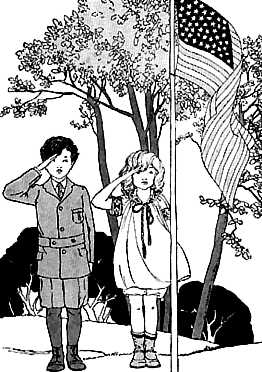War Is For Children: Reading, Writing and Recruitment

As a child I absolutely adored Cricket magazine, published by Carus Publishing. I now have a twelve-year old daughter who likewise enjoys their magazines for kids, but the May 2006 issue of Cobblestone Magazine floored me with its blatant pro-military marketing pitch to children.
Chances are, depending on your age, that either you or your children have read one of Carus’ publications at home, school, the library, or a doctor’s waiting room. For the smallest tykes—those under seven years old—they offer Ladybug, Babybug, and Click magazines. For six- to nine-year olds they put out Spider, Ask, and Appleseeds. And for the “tweens,” Calliope, Cobblestone, Cricket, Dig, Faces, Muse, Odyssey, and Cicada.
The Carus Corporation
Carus Publishing is part of the Carus Corporation, which also includes the Carus Chemical Company, specializing in “chemicals and services” for water and wastewater treatment, air purification and other environmental applications” according to its website. M. Blouke Carus is the Chairman and CEO of the Carus Corporation and serves, along with several family members, on the board of the Hegeler Carus Foundation, which, according to their IRS 990 filing, preserves the heritage of the Hegeler Carus mansion in La Salle, IL. This home belonged to the grandparents of Blouke Carus.
Blouke Carus has consistently kept conservative company. In 1982, Carus was appointed by then-President Ronald Reagan to the National Council on Education Research, which provides policy for the research areas of the U.S. Department of Education. Added to the Council at the same time were several prominent conservatives, including Onalee McGraw of the Heritage Foundation, and Penny Pullen of the American Legislative Exchange Council. In addition, George C. Roche was made chair of the Council at the same time. Roche was the President of conservative bastion Hillsdale College in Michigan, which according to its website “values the merit of each unique individual, rather than succumbing to the dehumanizing, discriminatory trend of so called ‘social justice’ and ‘multicultural diversity.’” It also does not accept federal student aid or loans of any kind, in order to avoid any federal control.
Duty, Honor, Country
The May 2006 issue of Cobblestone, titled Duty, Honor, Country, is unabashedly pro-military, appearing as if it were the product of military recruiters trying to market enlistment to children. According to the Boston Globe (registration required) Francis Lunney, a sixth-grade English teacher in Hudson, MA, immediately lodged a complaint with Carus Publishing, saying “It looked exactly like the [official recruiting] material you get in high school. It didn't seem to be that different the way it was packaged.”
The emphasis of the issue – and particularly the teachers’ guides – on the present and future of the military seems like an odd departure for Cobblestone. Look at their website’s list of upcoming themes and you will observe that they are squarely planted in the fairly distant past. The coming academic year will debut with issues on “Rediscovering Jamestown,” “The Battle of Yorktown,” “The Golden Age of the Steamboat” and “Ulysses S. Grant.” Similarly, the three months previous to the May 2006 issue covered “Those Roaring 20's,” “The Great War - Women Join the Fight - Breaking Barriers in World War I,” and “Ellis Island - Gateway to America.” Managing editor Lou Waryncia admitted to the Boston Globe that the current issue is out of the ordinary, but goes on to say that while they will weigh the criticism they received of this issue, they are considering issues dedicated to the Marines Corps, Navy, Air Force, and Coast Guard in 2008.
The two teacher’s guides provided free on the website are the work of Virginia Schumacher, the Visitor Services Manager at The History Center in Ithaca, New York, and Mary B. Lawson, a teacher at Michigan Avenue Elementary School in Saint Cloud, Florida and Florida Geographic Alliance Consultant. She defends the guides to the Boston Globe:
“Joining the military is a career option for any child. That doesn't suggest they should or should not. Recruiters go into the high school all the time. Part of the curriculum in New York state is career options and how to make wise choices. In that magazine, I felt they gave a wonderful portrayal of jobs that are not what everyone thinks of when they think of the Army. It was not meant to meant to offend anyone.”

This defensive stance is interesting on several levels. First, Ms. Schumacher herself refers to recruiters going into high schools, but the Cobblestone audience is elementary school and middle school/junior high students. In addition, the presence of recruiters and recruitment marketing has been very controversial even in high schools, with a growing grassroots movement of ‘counter-recruiting” being organized by people from coast to coast, many of them veterans and the families of American war casualties.
Schumacher stresses making “wise choices” about a future career but the issue did not include any counter arguments to balance the pro-military stance, so it is hard to see how it or the teacher’s guides are contributing to students’ wisdom about their futures. If she were truly interested in “wise choices” and didn’t intend to “suggest they should or should not” consider the military as a career, here are a few websites I would recommend adding to the teacher’s guide. The site for Iraq Veterans against the War. Or Veterans for Peace. And perhaps a link to a ten-minute video of Iraq War conscientious objector Aidan Delgado talking to students at Berkeley High?
Lawson’s guide contains some questionable suggestions. Under the Speakers/Interviews section, she recommends that teachers “invite an Army member, Army recruiter, and/or a war veteran to come and speak to your class.” (emphasis mine.) Under Writing, she promotes an activity that should have parents and child psychologists squirming:
“Using the articles, ‘An Eye to the Future: Opportunities in the Army’ and ‘Pick a Career, Any Career’ have the students read them and then pretend they are going to join the Army. Have them decide which career they feel they would qualify for and write a paper to persuade a recruiter why that should be the career they should be allowed to train for in the Army. When the papers are written, have them trade with a partner. The partner will read the paper and respond as a ‘recruiter’ as to why the writer will be allowed to train for that job, or why the ‘recruiter’ feels the writer would be better suited for another career. Share the results with the class.”
As the stepmom of a twelve-year old who is entering seventh grade in the fall, I would be aghast if she burst through the door with “Guess what! In my whole class, I’m the one that would be recruited by the Army first! And I even convinced them to let me do psyops!”
In the Research section of Lawson’s guide, there are six websites listed that teachers are encouraged to use to “research more information about the United States Army to help with reports and writings,” and to then have the children “share with the class new information found on the websites.” The suggested websites? Those of the US. Army, West Point, the Department of Defense, the National Museum of the U.S. Army, a portal to U.S. Army museum websites, and the U.S. Army Insignia home page.
Helping with the War Effort
 While this not-so-subtle military recruitment issue of Cobblestone may not be at the direct request of the military, it certainly fits nicely with their efforts. The military is hungry for fresh blood and needs opportunities to approach young people and pitch the joys of enlistment. In a June 2005 article in the Pittsburgh Post-Gazette, Kaye Cupples, executive director of support services for Pittsburgh Public Schools, notes that military recruiters, scrambling to meet quotas, “are getting very aggressive out there. Sometimes there are recruiters every day in the building in some of the larger high schools.”
While this not-so-subtle military recruitment issue of Cobblestone may not be at the direct request of the military, it certainly fits nicely with their efforts. The military is hungry for fresh blood and needs opportunities to approach young people and pitch the joys of enlistment. In a June 2005 article in the Pittsburgh Post-Gazette, Kaye Cupples, executive director of support services for Pittsburgh Public Schools, notes that military recruiters, scrambling to meet quotas, “are getting very aggressive out there. Sometimes there are recruiters every day in the building in some of the larger high schools.”
In addition, the No Child Left Behind Act of 2002 contains a clause allowing military recruiters direct access to personal information of high school students. According to the SourceWatch article, Michael Berg of the Carolina Peace Resource Center says “Today, military recruiters have unprecedented access to public schools. The little-known Section 9528 of the federal No Child Left Behind Act of 2001 grants the Pentagon access to directories of all public high schools (supplying them with student names, addresses and phone numbers) to facilitate contact for military service recruitment. A student or parent wishing to protect privacy must actively contact the school to opt out and protect their personal information. In some districts, it can be difficult to withhold information specifically from recruiters, yet still allow this information to be used for other purposes that parents and students may approve of, such as honor rolls or school TV shows.”
Nothing about military recruitment in high schools is left to chance. The twelve-page Army's School Recruiting Program Handbook outlines explicitly the steps to become an effective school recruiter. In the first section, titled “Purpose,” it states that the goal is “to provide a school calendar of events and significant activities and ensure an Army presence in all secondary schools. School ownership is the goal.” (italics mine.)
The calendar of events will keep any recruiter busy and out of trouble. September is a particularly busy month:
- “Many communities have Labor Day activities, parades, etc. Get involved through the local chamber of commerce. If your school has a color guard, offer to train them in drill and ceremonies. Obtain a tactical vehicle from a local USAR troop program unit and drive it in the parade with your future Soldiers riding along.”
- “The HS registration may be hectic. Go to the HS, offer your assistance in registration and any other administrative help you can give. Remember: You need all the blueprint information on your HS you can get. The good HS program is a proactive one; the early bird gets the worm. This means, first to contact, first to contract.”
- “Coordinate with school officials to eat lunch in the school cafeteria several times each month. This will give you more visibility, and will help you identify potential candidates for any opportunities and enhance your contact milestones.”
- “Deliver donuts and coffee for the faculty once a month. This will help in scheduling classroom presentations and advise teachers of the many Army opportunities.”
Recent Developments
As I was finishing this article I returned to the Cobblestone website to check some facts and found an editorial response to the controversy that this issue has generated. Read their rebuttal for yourself, but here are a some of their defensive assertions which I contest, and most of which I have addressed earlier in this article.
Cobblestone’s assertion:
“America's present political divide and involvement in the Iraq War has unexpectedly made our issue a controversial topic. Despite what one thinks about our current military involvement, we believe it is possible to report about the history of the U.S. Army without delving into the politics surrounding it. Contrary to some reports or interpretations, our issue does not condone or promote war.”
Reality check:
It is disingenuous to pretend that the military can be separated from the politics that drive its involvement in conflicts. To imply that military actions are divorced from politics is particularly irresponsible when the audience is children who may not have other sources to use to round out their perspective.
Cobblestone’s assertion:
“Is our issue appropriate for children ages 9 to 14? We believe it is. Each month we try to produce an unbiased, thoughtful, content-driven history magazine. We introduce readers to topics, help them to understand them, and hope they are motivated to learn more. While we did not create our Army issue to start a political debate or instigate controversy, we feel our presentation is an ideal catalyst for discussion about the U.S. Army and its role in America today. The issue can be used as a resource for discussing different views on the Army and its many components.”
Reality check:
The style and presentation – complete with cartoons, quizzes, kid-friendly fonts, words like “awesome”, and photos of young people in camouflage – are certainly marketed toward 9 to 14 year-olds, but the controversial subject matter is inappropriate and one-sided. This is the most insidious aspect of this issue. For instance, the back inside cover is a cartoon abut how all different kinds of animals have also served in the armed forces, including the cell that reads “dolphins and sea lions have worked in Vietnam and the Persian Gulf wars to keep waterways safe by detecting mines and underwater explosives.” Again, Cobblestone chooses to not give a balanced view by including either information on dolphins that have not returned after a mission or that there is opposition to them being used by the military from various animal rights groups.
Cobblestone’s assertion:
Unfortunately, some of the news reports and letters we have received have charged us with “recruiting” young people for military service and slanting the issue in favor of the Army. Neither point is true.
Reality check:
While not explicitly telling children to enlist, there is little in the issue to dissuade and much to persuade. For instance, in an “interesting facts” section called Did You Know?, they note:
Legendary rock-and-roll musician Elvis Presley served in the U.S. Army from 1958 to 1960, rising to the rank of sergeant. Other celebrities with a background in the Army include Art Carney, James Garner, Tony Bennett, Jimi Hendrix, John Fogerty, Charles Durning, Sammy Davis, Jr., Clint Eastwood, Burt Lancaster, James Arness, Mel Brooks, James Coburn, Ossie Davis, Robert Duvall, Hall Holbrook, Kris Kristofferson, Richard Pryor, Tony Randall, and Gene Wilder.
This is standard marketing – be cool like them and join the military. What is notable about the list, besides its length, is that it makes no mention of how many of those celebrities were drafted, and therefore not necessarily willing participants in the military. It is deceptive to list Jimi Hendrix (one of the better known artists to young people) without mentioning that he was discharged from the Army and that his commanding officer wanted to discharge him because “In comparison with the performance of other men in his unit, serviceman is one of the poorest.” Hendrix became an outspoken and leading opponent of the war in Vietnam, penning such songs as “Machine Gun” and speaking out at concerts in favor of veterans who opposed the war. Not surprisingly, there is no nod to Hendrix’s anti-war lyrics like these, from Machine Gun:
Machine gun
Tearing my body all apartMachine gun, yeah
Tearing my body all apartEvil man make me kill ya
Evil man make you kill me
Evil man make me kill you
Even though we’re only families apart

An even more compelling omission is that of Muhammad Ali, who refused to serve in the military during the Vietnam War by saying “I have searched my conscience, and I find I cannot be true to my belief in my religion by accepting such a call.” Similarly, he recited, “Keep asking me, no matter how long/On the war in Viet Nam, I sing this song/I ain't got no quarrel with them Viet Cong.” Ali was convicted of refusing to report for service after having been drafted and was sentenced to a five-year prison term, in addition to losing his heavyweight title. The U.S. Supreme Court only reversed his conviction for draft evasion in 1971. The editors of Cobblestone would not have had to look hard to find inspiring – and thought-provoking – quotes from Ali like the following:
I'm expected to go overseas to help free people in South Vietnam, and at the same time my people here are being brutalized and mistreated, and this is really the same thing that's happening over in Vietnam. So I'm going to fight it legally, and if I lose, I'm just going to jail. Whatever the punishment, whatever the persecution is for standing up for my beliefs, even if it means facing machine-gun fire that day, I'll face it before denouncing Elijah Muhammad and the religion of Islam.
By ignoring these examples of resistance to military service – and the stories of many conscientious objectors much less famous – they create an undeniable slant in favor of the military in this issue of Cobblestone.
Cobblestone’s assertion:
“We did not publish an issue on the U.S. Army to support any political agenda or to endorse military recruitment. We simply wanted to report on the history of an institution that affects and influences American life. We'd also like to note that the Army was not involved editorially or financially in producing the issue. As a magazine that advocates the importance of history, we are saddened by the political tug of war over our content. To really understand history we believe it should be discussed and debated, not avoided or censored. We encourage you to thoroughly read this issue of COBBLESTONE. Once you do, we're sure you'll come to the same conclusion.”
Reality check:
Whether or not active military were involved editorially, or whether the Army gave any financial support for this issue, the influence is clear. The consulting editor for this issue was Matthew Seelinger, who is the Chief Historian for the Army Historical Foundation. In addition, the Army provided many of the photos for the issue according to the Picture Credits on page 46.
I find it ironic that they are “saddened” by the “political tug of war” over this issue. As a parent, and as a historian, I am more than saddened by their poor judgment in publishing this issue.





Comments
Military Recruiting of Elementary School Children
I object to the ongoing military recuiting that is allowed at our local (Westlake, Ohio) elementary schools. To have my son and daughter receive regular mailings from various branches of the military to encourage them to contact the local recruiting office is objectionable for children of elementary school age. My kids also return from their schools' "career day" -- where they are introduced to various professions -- talking about the "fun" presentations by various representatives of the U.S. armed forces. Why is this allowed? What can we do about it?